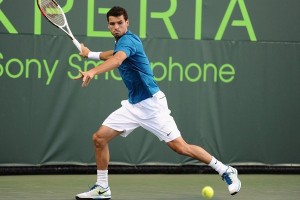By Thomas Swick
A little after 11 Friday morning, Aleksandra Wozniak stretched in the grass outside Court 6, said final words to her coach (and father), and walked into the petit arena, where she waited a long five minutes for her opponent, Monica Niculescu, to arrive. Gamesmanship? Or Miami traffic?
The Canadian looked thicker of body than I expected her to. I used to think that hockey was the one sport you had to see in person to truly appreciate its speed and power. But with the improved racket technology, tennis is now in the same category. Sit in the stands at a tennis match and three things happen: the court grows smaller than on TV, the players grow bigger, and the ball moves faster. And the closer you sit, the smaller, bigger and faster the three respectively become.
Also, without the drone of an announcer, sounds become more pronounced: the ball off strings, the grunts from players. (TV catches only the barks of bawlers like Sharapova and Azarenka.) At the outside courts you can hear the balls, applause, line calls, even the squeaking sneakers from neighboring courts, and, occasionally, the announcements from the bigger courts. You see, and hear, what a grueling, repetitive job tennis is. AfterNiculescu won the first set she walked to her chair with an expression not of joy but of exhausted relief.
The couple sitting next to me was speaking French. I asked if they were from Canada; they said they were, as was Wozniak. “She has a Polish name, but she’s from Quebec.”
I headed over to Court 7, where Kaia Kanepi was playing Silvia Soler-Espinosa. Alot of blond people were seeking the meager shade of the top row.
“Most of this row is Estonian, I think,” a woman in a sunhat told me. “There is a small Estonian community here in Miami.”
Liivi, though, was visiting from Tallinn, and was a Djokovic fan. “I think it’s a shared passion for a nation that has suffered a lot,” she said, giving one of the most thoughtful explanations of fandom I had ever heard. As her countrywoman fell behind she said resignedly: “This hot environment is not so much in favor of Kaia. Last year she was so bland, didn’t move a lot.”
I wished her well and headed out, arriving back at Court 6 just in time to see a tearful father hugging his victorious daughter. “She came back from 1-4 down to win,” a woman with a Quebec accent told me with delight. “This was a big win for her. I’m very happy – she’s such a sweet person.”
Canada had an even larger presence late in the afternoon on Court 2 when Milos Raonic played Arnaud Clement. (In contemporary tennis, as in contemporary life, names have little relationship to nationality.) I sat next to a man from Toronto waving a Canadian flag and a man from New Brunswick whose wife waved a parasol-hat that was printed in the design of the Canadian flag.
“Are you Canadian too?” I asked her.
“No,” she said.
“She’s from a country with the same flag but without the maple leaf,” her husband said.
“Peru,” I said.
“”Yes,” she said. “We say they stole our flag and just put a maple leaf on it.”
The tall, lanky, thick-haired Raonic looked like a young Garrison Keillor in shorts. “He’s a good, clean-cut kid,” the man from Toronto told me, before adding with a smile: “Like all Canadians.” Then he brought up the War of 1812. “The only war we beat you in.”
At one of the changeovers, Clement motioned for the towel and when it didn’t come fast enough he gestured to the ballgirl with an impatience that seemed to suggest he was gushing blood, not dripping sweat.

I returned to Court 2 around dusk for the Grigor Dimitrov and Juan Ignacio Chela match. I expected a large Argentinian contingent, and was not disappointed; a few blue-white-and-blue flags were in evidence. But there were also two Bulgarian flags, and a small but vocal Slavic group sitting in the front of the western stands.
“We came from Orlando,” one woman told me. “Except for her,” she touched her neighbor’s arm. “She’s from West Palm Beach.”
“We’re very loud,” the second woman said. “I apologize.”
When Dimitrov broke Chela in the third set, they got even louder. There were some long, fierce, riveting rallies, Dimitrov racing back and forth along the baseline, dipping so low for some balls and stretching so far, that he seemed to fall. But, miraculously, he ripped the ball back and regained his footing. When he won the final point, the Bulgarians erupted with joy, and even the Argentinians stood and applauded in acknowledgement and appreciation of the hard-fought battle.
